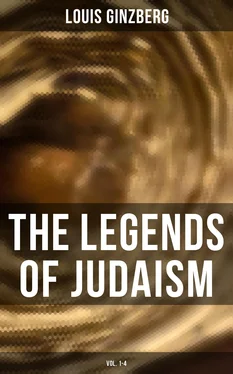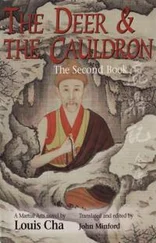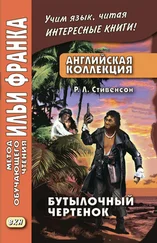Louis Ginzberg
The Legends of Judaism
(Vol. 1-4)
Published by

Books
- Advanced Digital Solutions & High-Quality eBook Formatting -
musaicumbooks@okpublishing.info
2020 OK Publishing
EAN 4064066392604
Volume 1 Volume 1 Table of Contents
Volume 2
Volume 3
Volume 4
Table of Contents Table of Contents Volume 1 Volume 1 Table of Contents Volume 2 Volume 3 Volume 4
Table of Contents
PREFACE
I THE CREATION OF THE WORLD
II ADAM
III THE TEN GENERATIONS
IV NOAH
V ABRAHAM
VI JACOB
Table of Contents
Was sich nie und nirgends hat begeben, das allein veraltet nie.
The term Rabbinic was applied to the Jewish Literature of post-Biblical times by those who conceived the Judaism of the later epoch to be something different from the Judaism of the Bible, something actually opposed to it. Such observers held that the Jewish nation ceased to exist with the moment when its political independence was destroyed. For them the Judaism of the later epoch has been a Judaism of the Synagogue, the spokesmen of which have been the scholars, the Rabbis. And what this phase of Judaism brought forth has been considered by them to be the product of the schools rather than the product of practical, pulsating life. Poetic phantasmagoria, frequently the vaporings of morbid visionaries, is the material out of which these scholars construct the theologic system of the Rabbis, and fairy tales, the spontaneous creations of the people, which take the form of sacred legend in Jewish literature, are denominated the Scriptural exegesis of the Rabbis, and condemned incontinently as nugae rabbinorum.
As the name of a man clings to him, so men cling to names. For the primitive savage the name is part of the essence of a person or thing, and even in the more advanced stages of culture, judgments are not always formed in agreement with facts as they are, but rather according to the names by which they are called. The current estimate of Rabbinic Literature is a case in point. With the label Rabbinic later ages inherited from former ages a certain distorted view of the literature so designated. To this day, and even among scholars that approach its investigation with unprejudiced minds, the opinion prevails that it is purely a learned product. And yet the truth is that the most prominent feature of Rabbinic Literature is its popular character.
The school and the home are not mutually opposed to each other in the conception of the Jews. They study in their homes, and they live in their schools. Likewise there is no distinct class of scholars among them, a class that withdraws itself from participation in the affairs of practical life. Even in the domain of the Halakah, the Rabbis were not so much occupied with theoretic principles of law as with the concrete phenomena of daily existence. These they sought to grasp and shape. And what is true of the Halakah is true with greater emphasis of the Haggadah, which is popular in the double sense of appealing to the people and being produced in the main by the people. To speak of the Haggadah of the Tannaim and Amoraim is as far from fact as to speak of the legends of Shakespeare and Scott. The ancient authors and their modern brethren of the guild alike elaborate legendary material which they found at hand.
It has been held by some that the Haggadah contains no popular legends, that it is wholly a factitious, academic product. A cursory glance at the pseudepigraphic literature of the Jews, which is older than the Haggadah literature by several centuries, shows how untenable this view is. That the one literature should have drawn from the other is precluded by historical facts. At a very early time the Synagogue disavowed the pseudepigraphic literature, which was the favorite reading matter of the sectaries and the Christians. Nevertheless the inner relation between them is of the closest kind. The only essential difference is that the Midrashic form prevails in the Haggadah, and the parenetic or apocalyptic form in the pseudepigrapha. The common element must therefore depart from the Midrash on the one hand and from parenesis on the other.
Folklore, fairy tales, legends, and all forms of story telling akin to these are comprehended, in the terminology of the post-Biblical literature of the Jews, under the inclusive description Haggadah, a name that can be explained by a circumlocution, but cannot be translated. Whatever it is applied to is thereby characterized first as being derived from the Holy Scriptures, and then as being of the nature of a story. And, in point of fact, this dualism sums up the distinguishing features of Jewish Legend. More than eighteen centuries ago the Jewish historian Josephus observed that "though we be deprived of our wealth, of our cities, or of the other advantages we have, our law continues immortal." The word he meant to use was not law, but Torah, only he could not find an equivalent for it in Greek. A singer of the Synagogue a thousand years after Josephus, who expressed his sentiments in Hebrew, uttered the same thought: "The Holy City and all her daughter cities are violated, they lie in ruins, despoiled of their ornaments, their splendor darkened from sight. Naught is left to us save one eternal treasure alone—the Holy Torah." The sadder the life of the Jewish people, the more it felt the need of taking refuge in its past. The Scripture, or, to use the Jewish term, the Torah, was the only remnant of its former national independence, and the Torah was the magic means of making a sordid actuality recede before a glorious memory. To the Scripture was assigned the task of supplying nourishment to the mind as well as the soul, to the intellect as well as the imagination, and the result is the Halakah and the Haggadah.
The fancy of the people did not die out in the post-Biblical time, but the bent of its activity was determined by the past.
Men craved entertainment in later times as well as in the earlier, only instead of resorting for its subject-matter to what happened under their eyes, they drew from the fountain-head of the past. The events in the ancient history of Israel, which was not only studied, but lived over again daily, stimulated the desire to criticize it. The religious reflections upon nature laid down in the myths of the people, the fairy tales, which have the sole object of pleasing, and the legends, which are the people's verdict upon history—all these were welded into one product. The fancy of the Jewish people was engaged by the past reflected in the Bible, and all its creations wear a Biblical hue for this reason. This explains the peculiar form of the Haggadah.
But what is spontaneously brought forth by the people is often preserved only in the form impressed upon it by the feeling and the thought of the poet, or by the speculations of the learned. Also Jewish legends have rarely been transmitted in their original shape. They have been perpetuated in the form of Midrash, that is, Scriptural exegesis. The teachers of the Haggadah, called Rabbanan d'Aggadta in the Talmud, were no folklorists, from whom a faithful reproduction of legendary material may be expected. Primarily they were homilists, who used legends for didactic purposes, and their main object was to establish a close connection between the Scripture and the creations of the popular fancy, to give the latter a firm basis and secure a long term of life for them.
Читать дальше













